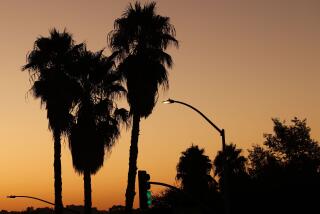A Dangerous Heat
- Share via
Not even the fact that it was, as they say, a dry heat came as much consolation to northern Los Angeles County residents who broiled through last week’s successive days of 100-plus temperatures. Yet as heat in the rest of the country produces deadly results, triple-digit temperatures in the Antelope, San Fernando and Santa Clarita valleys traditionally yield little beyond discomfort.
It’s not that Southern Californians are any heartier than residents of Dallas or Chicago. In fact, the drier heat of the past week can pose even greater dangers to the unprepared. The region’s apparent resistance to extreme heat is instead more a function of how the communities north of downtown Los Angeles developed. In the post-World War II building boom that filled the valleys north of the Santa Monica Mountains, many of the homes came with cooling systems--unlike much older neighborhoods in the East. Plus, relatively new malls, movie theaters and recreation centers provide air-conditioned relief from the heat.
Outside, though, the risks of dehydration and heat exhaustion are considerable--particularly for the old and the young who may not be able to detect the stress on their bodies. The relatively dry weather fools people into thinking they are not as hot or as dehydrated as they may be. Because sweat evaporates more quickly in dry heat, it’s easy not to perceive it--and consequently not drink enough to replace it. The potential result: dehydration, which is marked by malaise, weakness and difficulty in concentrating.
The doctors’ advice for the heat is relatively simple: Stay inside, drink plenty of fluids and exercise less. Air conditioners and swimming pools may guard against the heat, but they are not foolproof. As Dr. Loren Lipson, head of geriatrics at the USC School of Medicine, put it last week, “We may think we’re very secure, but we’re very frail and fragile against Mother Nature.”
More to Read
Sign up for Essential California
The most important California stories and recommendations in your inbox every morning.
You may occasionally receive promotional content from the Los Angeles Times.













